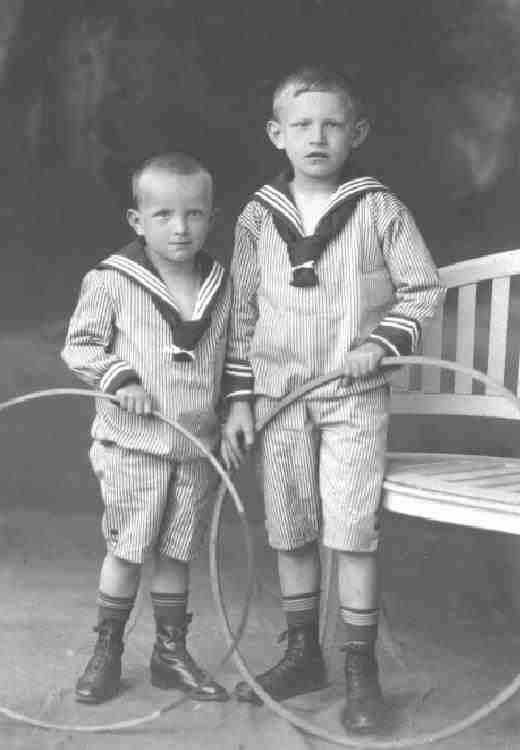
Sailor Suits: Germany--Colors and Patterns: Striped Suits

Figure 1.--These German boys wear matching striped sailor suits. The sailor suit as the Kaiser strove to build a navy to rival the British became extremely popular--a source of national pride. The sailor suit continued to be popular for boys even after World War I. Notice the hoops which the boys no doubt enjoyed rolling in the park. The photograph appears to have been taken in the early 1920s. Notice the buttons on the hem of their knerepants.
|
|
German boys most commonly wore solid colors, but some mostly summer suits were striped. These striped suits appear to have been especially popular in Germay. We are not entirely sure about the chronology. We have not noted them in the 19th century, but our archive is still limited. We note them throughout the early 20th century. The suits were most commonly white with blue stripes, but there were other color combinations as well. This is hard to determine with the black-and-white photographt of the day. The width of the stripes varied from suit to suit. This is one style which was not copied from actual naval uniforms, but appears to be an inovation for children only. They were normally a style for summer wear and were made from lighter fabrics than the wooleb fabrics that dark blue suits were often made. As they were for summer wear, we often see boys wearing them without dickies. We notice knee pants and short psants striped suits, but not long pants sailor suits done with stripes. A good example of a short pants suit is an unidentified boy, we think in the late 1920s. This boy wore long stockings. An other unidentified boy wore knee socks.
Popularity
German boys most commonly wore solid colors, but some mostly summer suits were striped. These striped suits appear to have been especially popular in Germay.
We are not entirely sure about the chronology of striped sailor suits in Germany. We have not noted them in the 19th century, but our archive of 19th century German images is still limited. Thus this may just reflect the availability of images. We know much more about the 20th century. We note striped sailor suits throughout the early 20th century. We have both formal portraits s well as many familiy snap shots which became common after the turn-of-the 20th century. We notice quite a few photgraphs of striped suits from the 1900s-early 30s. They began to become less common as sailor suits declined in popularity after the mid-1930s.
Colors
The suits were most commonly white with blue stripes, but there were other color combinations as well. This is hard to determine with the black-and-white photographt of the day. We think there may have been other colors, but we can not yet conform this.
Stripe Width
The width of the stripes varied from suit to suit.
Origins
This is one style which was not copied from actual naval uniforms, but appears to be an inovation for children only. We are not sure why striped silor suits became popular. It may have just been a popular fashio. Perhaps the striped suit did not show dirt as much as solid color suits. Here we are just not sure.
Seasonality
They were normally a style for summer wear and were made from lighter fabrics than the woolen fabrics that dark blue suits were often made. Presumably they were made in many of the same materials that the white suits were made.
Collars abd Cuffs
Most of the stried suits we have noted came with dark (presumably blue) collars with the standard three-stripe detailing. This was often repeated on the cuffs, although there were variations such as doing the three stripes as chevrons. Some blouses didn't have the special sleeve treatment.
Dickies
As they were for summer wear, we often see boys wearing them without dickies. We assume that most cme with removalable dickies, but we can not conform this.
Pants
These suits were made with striped middy blouses and matching striped pants. We notice knee pants and short psants striped suits, but not long pants sailor suits done with stripes. A good example of a short pants suit is an unidentified boy, we think in the late 1920s. Some boys wore striped middy blouses with dark pants. We see white pants less commonly. We are nor sure if somesailor suits came with striped middy blousesand dark pants or if the boys and their mother mixed and matched at home.
Hosiery
Some boys wore long stockings with these striped suits. Other boys wore knee socks. We note one unidentified boy wore knee socks.
Usage
The striped sailor suits, like regular sailor suits, were remarkably flexible garments. We see boys wearing them for play as well as for formal occassions like weddings. Boy may have had more than one suit and the oldr one used for play. We also notice many boys wearing these suits to school. A good example is an unidentified boy at work on his lessons in the 1930.
Gender
HBC

Navigate the Boys' Historical Clothing Web Site:
Sailor Suit Country Related Pages:
[Returnt to the Main German sailor suit colors and pattern page]
[American]
[Denmark]
[English]
[French]
[German]
[Italian]
Other Related Pages:
[Sailor suits]
[Kilts]
[Smocks]
[Pinafores]
[Sailor Hats]
[Blouses]
[Ring Bearers]
[Long hair]
[Ringlet curls]
[Hair bows]
[Bangs]
[Collars]
[Bows]
Navigate the Boys' Historical Clothing Web Site:
[Return to clothing styles]
[Introduction]
[Activities]
[Biographies]
[Chronology]
[Cloth and textiles]
[Clothing styles]
[Countries]
[Topics]
[Bibliographies]
[Contributions]
[FAQs]
[Glossaries]
[Images]
[Links]
[Registration]
[Tools]
[Boys' Clothing Home]
Navigate the Historic Boys' Clothing Web German pages:
[German choirs]
[German country page]
[German school wear]
[Lederhosen]
[German scouts]
[German royal family]
[Hitler youth]
Created: July 20, 2001
Last updated: 10:49 PM 2/16/2008



